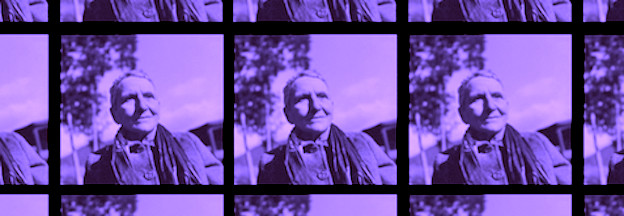'Tender Buttons': A pedagogy

In the Autobiography of Alice B. Toklas, Stein describes a shift in the character of her writing from “[having] been interested only in the insides of people, their character and what went on inside them” to “a desire to express the rhythm of the visible world.” After hearing that Donald Evans was interested in publishing Tender Buttons, Stein via Toklas again describes this work as “the beginning of mixing the outside with the inside … she began to describe the inside as seen from the outside.”
I begin with these moments from the Autobiography of Alice B. Toklas because much of my love of this text stems from my experience working with it in the context of the required first-year college composition course, a course that asks (or should ask) students to rethink their modes of writing academically. Appropriately, for Stein herself, Tender Buttons represents this kind of risk — an intentional movement from the portraiture of people, of the “inside,” to a wholly different kind of painting — one that orbits around the “outside” — literally, “objects, food, rooms.” In “How to Read How to Write: Bothering with Gertrude Stein,”[1] Sharon J. Kirsch looks at the “compositional concepts” Stein explores in How to Write, positing that Stein’s work asks readers to rethink composition and reading her compositions as “taking risks, playing on syntactic and semantic levels, bothering with her poetic mischief, and finding pleasure in words, their arrangements, their demands, their omissions, their serious suppositions, their gnomic pronouncements, and their prepositional virtuosity.”
Tender Buttons is, in my experience, the gateway to engaging students in the potential that writing holds — seeing and seeking “pleasure in words” as their own entities, and straying from the formulaic models of what might constitute acceptable prose. I often use Stein, and excerpts from Tender Buttons,[2] as invitations for students to write.
What follows are two of these moments, from very different classrooms, with my accompanying teaching notes:
“A Carafe, That Is A Blind Glass” (Scenario: Composition II class, paper 2 revision workshop)
— Hear the piece read out loud two times — first, with one person reading the entire thing, then, alternating readers at each punctuation mark.
— Encourage students to annotate as they listen (marking moments they love and moments they feel puzzled by).
— Focused free write: First thoughts. What do you notice?
— Copy into your notebook: “All this and not ordinary, not unordered in not resembling. The difference is spreading.”
— Focused free write: Imagine this is the comment left on your rough draft. What would you now do to revise your paper and why?
— Share in small writing groups.
“A Long Dress”
(Scenario: Writing to Learn Professional Development day with interdisciplinary high school faculty)
— Handout “A Long Dress” — just the text with no author and no bibliographic information.
— Read the piece out loud four times — once straight through with one reader, once alternating readers by punctuation mark, once backwards, and finally, again straight through with one reader.
— Focused free write one: What is this piece about? Or, what is this piece?
— Focused free write two: What do you feel like you’d need to know in order to come to a reading of this text? Why?
— Share only focused free write two.
— Focused free write three: Perform a close reading of the text via a line-by-line translation of it. In other words, focus on the text at a sentence level and translate it in whatever way you see fit. Write yourself into the text.
— Share.
— Process write: Reveal the bibliographic information (with no context). What did you need to do in order to translate “A Long Dress”? Where is your thinking now about how to work with students to find their way into a text they might initially feel outside of? Do you still want/need contextual information?
— Share. Discuss classroom applications.
A brief note on rationale: I chose to share these two particular moments because they are moments when Tender Buttons was used as a vehicle to work with students to get towards a specific goal — to work towards a final draft of a paper and to work towards thinking about how to engage students when they “shut down” as a result of being handed a “difficult” text. And, I chose to share these two particular moments because I think they demonstrate that Stein’s writing is always and ever useful in any scenario.
1. Sharon J. Kirsch, “How to Read How to Write: Bothering with Gertrude Stein,” in Primary Stein: Returning to the Writing of Gertrude Stein, ed. Janet Boyd and Sharon J. Kirsch (Plymouth, United Kingdom: Lexington Books, 2014), 109–24.
2. Gertrude Stein, Tender Buttons: The Corrected Centennial Edition (San Francisco: City Lights Books, 2014).